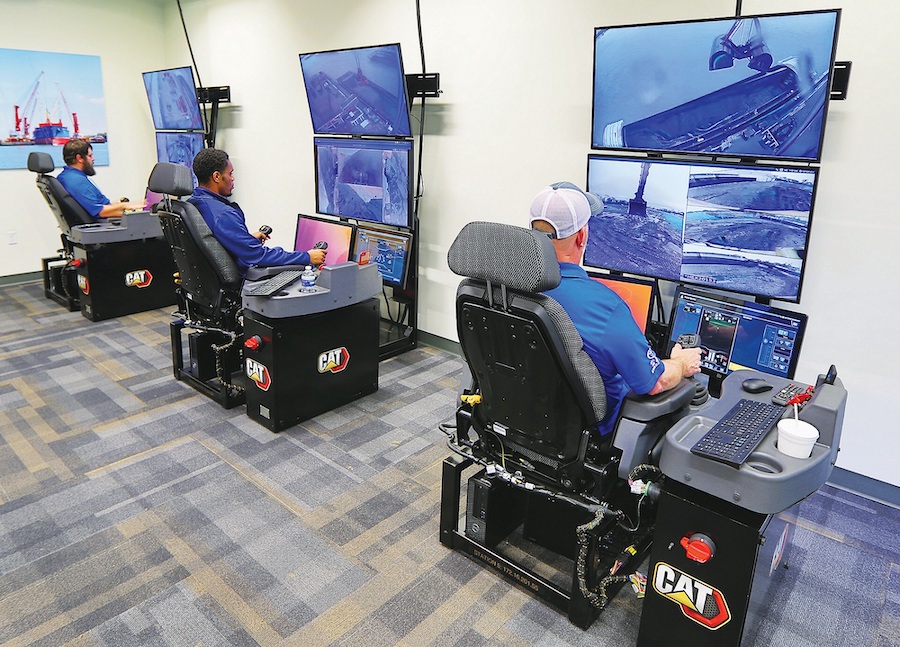Miners are looking to digitalization and automation to increase productivity and safety and lower costs. Here’s a look at some of the suppliers that are offering up crucial connectivity, equipment and software solutions.
ABB
ABB is a leader in process automation, electrification and digitalization, control technologies, software, measurement and analytics for the process and hybrid industries. Clients of the Swiss company include the mining, oil and gas, aluminum, steel, cement, chemical, marine, refining and printing industries.
ABB is installing its enterprise- grade digital platform ABB Ability Genix industrial analytics and AI suite in Gold Fields’ (NYSE: GFI; JSE: GFI) Salares Norte project in Chile, which will begin production in 2023. The platform will provide efficient, sustainable, safe remote operations, reducing the number of staff and lowering operating costs, and allowing remote monitoring to take place in Santiago, over 1,000 km away. The solution integrates electric, automation and digital technologies.
The Genix platform combines industrial analytics and artificial intelligence to integrate 25 engineering, operational, and information technology systems across functional areas including mines, processing, geology and exploration, asset management, finance, legal, and human resources. It then collects and converts data into meaningful information to improve productivity.
Its Ability MineOptimize solution is already supplying an integrated power and automation system at Gold Fields’ Salares Norte under ABB’s Ability System 800xA distributed control system (DCS). These include its Power and Process Control Library and Camera Connect (the ABB video system embedded in the control platform for optimized process monitoring). ABB Ability knowledge manager also handles information production through a plant information management system (PIMS), alongside its Ability Asset Vista condition monitoring.
Salares Norte is expected to produce 3.7 million oz. of gold over an initial mine life of 11 years. The open pit mine will supply 2 million tonnes per year to the mill.
ABB has also been selected by BHP to deliver a power management system for the US$5.7-billion Jansen potash project in Saskatchewan, which is expected to begin production in 2026. It will cover electrical substation equipment remotely, reducing the time needed for diagnosis and problem solving. This project will be the largest potash mine in the world, with an initial capacity of 4.5 million tonnes per year and potential for 16 to 17 million tonnes per year.
CATERPILLAR
For nearly 100 years, Texas-headquartered Caterpillar has provided equipment and technology solutions for the mining, defence, government, oil and gas, paving, construction, forestry, electric and industrial power, and OEM industries.
The company offers the broadest line of mining equipment in the industry, with its products used worldwide for both underground and surface mines for drilling, digging, loading, hauling, grading, and dozing.
Its MineStar suite of technology products now includes the Cat MineStar Reporting platform, an analytics and reporting product that consolidates information from MineStar and other technologies into a single interface. Data is accessed from a comprehensive database using a web browser on any connected device. The reports and dashboards are suitable for single or multiple mine sites and also work efficiently with other non-Caterpillar products. This system allows users to create customized reports and receive automated email reports. Currently, it supports information from Caterpillar MineStar Fleet, Terrain, Health, and Command for Hauling. All Cat products will eventually be supported.
Standard production reporting includes management and movement summaries, benches mined, cycle details, truck production, and grade movement and summary. Equipment performance, time stats and delay overview, activity calendar, fleet timeline, and event details are included in the time report. The drill report provides drilling accuracy, hole list and drilling information.
In fall 2022, Caterpillar reached a milestone in autonomous haulage, with trucks equipped with MineStar Command for hauling surpassing a total of 5 billion tonnes of material hauled.
In Alberta, Suncor is deploying a remote Caterpillar DSS accelerated collision avoidance and fatigue management system for all of its mobile mining equipment. The system is already installed at Syncrude’s Mildred Lake and Aurora mines and will be installed in its remaining mines by early 2023.
DSS is a configurable two-part system combining real-time fatigue and distraction alerts and remote monitoring services. It measures the eyelid closure and head position during machine operation when the system is active. The DSS includes a high-powered computer, driver facing camera and Infrared (IR) lights for eye and face tracking. A forward-facing camera measures hard braking and cornering or impacts. A speaker relays audible alerts to the operator, and a GPS module tracks the truck location, orientation, and vehicle speed.
HARD-LINE
Established in 1996, in Sudbury, Ont., Hard-Line is a leading supplier of automation, teleoperation, and remote-control technology designed for the mining industry. The now global company has offices in the United States, Chile, and Peru, and a worldwide distribution network. Hard-Line’s remote-control systems allow operations through direct/extended line of sight, or teleoperation in underground mines, which increases worker safety, continuous production and mine profitability.
In collaboration with Murray Engineering, and Beltor Engineering, Hard-Line helped create a quicker and safer way of recovering buried vehicles in underground mines. Using a mine extraction device (MED) provided by Beltor and remotely operated using Hard-Line’s Radio Remote Control (RRC), machines can be recovered in two to five days from a safe distance rather than weeks with traditional methods using loader and haul trucks. The technology can be operated remotely up to 100 metres away with live video, and has been successfully used at underground mines all over Australia since 2020.
For the open pit market, Hard-Line has developed partnerships with Hexagon and Liebherr to develop autonomous solutions such as collision avoidance, GPS, and drilling patterns. Hard-Line’s TeleOp system allows the tele-remote operation of heavy machinery from a control station on the surface or underground, regardless of distance. The system offers increased profitability, production, efficiency, user friendly software and the ability to continue mine operations during a shift change.
HEXAGON
Sweden-based company Hexagon has been offering digital solutions for 25 years, combining sensor, software, and autonomous technologies. Its mining applications include surveying, design, fleet management, production optimization and collision avoidance capabilities.
Hexagon’s mining division introduced its Power of One platform at its digital solutions conference HxGN Live Global in 2022. The platform is a life-of-mine smart solution connecting sensors, software, infield apps and cloudware. It connects the mine to the boardroom with a smart computer, antenna, and display. Data from multiple sensors connects exploration, planning, drilling, and blasting, material movement and monitoring activities. Hexagon says the solution streamlines processes, reduces costs, and improves safety and productivity.
The company’s other industry software includes HxGN Mine Enterprise which converts data into real time information, HxGN Mine Protect which offers proximity detection, HxGN Mine Operate, which provides monitoring solutions, HxGN Mine Measure software for drilling and blasting, and HxGN Mine Plan, which helps companies build projects from exploration to production.
The latest release of HxGN MinePlan enhances functionality for MinePlan 3D, MinePlan Schedule Optimizer and MinePlan Project Evaluator, adding improved speed and performance.
The new reserves engine is now integrated into the Autoslicer tool, allowing users to choose reserve logic setups to slice by tonnes as a target. This allows users to quickly generate shapes to meet planning requirements.
MinePlan Schedule Optimizer (MPSO) combines optimal and manual scheduling with both mid-range planning and hybrid scheduling. Block Schedule Coding is a new feature that allows users to code back MPSO period and destination schedule results to the block model. Shovel Control assigns shovels to areas, phases, benches, and cuts. Users can limit the number of shovels applied to a given cut per period and helps generate operational schedules.
MinePlan Project Evaluator ensures a user’s long-term plan starts with an economically optimized shell.
Hexagon has also introduced HxGN MineMeasure Detect, a 3D camera hardware, software, and data solution. MineMeasure Detect enables real-time optimization for plant production with automated digital-image analysis. This provides continuous, accurate and rapid measurement of oversize, volume, rock fragmentation and colour. The system also offers critical early warning notifications for operators to avoid catastrophic production stoppages. This solution has been tested at Capstone Mining’s Pinto Valley copper mine in Arizona.
NOKIA
Nokia’s private wireless solutions are helping mining operators worldwide to digitalize. Nokia pioneered private LTE in mining 10 years ago with Rio Tinto (NYSE: RIO; LSE: RIO; ASX: RIO) in Australia, and has now deployed more than 65 private wireless mining networks for over 35 mining companies worldwide. It now also offers a “straightforward” path to upgrade from its private 4.9G/LTE network to 5G.
In Canada, Nokia recently partnered with Symboticware, an industry leader in real-time data management solutions for mining, on private wireless and industrial internet-of-things (IoT) to transform connectivity and improve communications and location services. The partnership offers a complete digital solution with real-time connectivity for the underground mining industry and enables artificial intelligence (AI) and machine learning using Symboticware’s telemetry technology. The solution has been implemented at the Norcat underground centre in Sudbury, Ont., and has been available since 2021.
Industrial-grade private wireless provides underground operations access to accurate location tracking of equipment and personnel and the ability to drive autonomous trucks, ultimately streamlining operations and improving productivity and safety.
RPMGLOBAL
For over 50 years, Australia-headquartered RPMGlobal has been providing mining technology solutions including innovative software to create safer, more efficient, and sustainable operations.
RPMGlobal launched its mobile asset management solution, AMT Mobile in 2022. This mobile application allows field technicians, managers, and supervisors to digitize forms and processes while operating remotely. It can be used both on or offline, making it ideal for underground operations or sites without Wi-Fi coverage. RPM says the technology helps increase productivity and ensures compliance and safety requirements are met.
Users choose from an asset centric focus (Asset View) to complete activities or work activity view (Work View). Both views operate together so users can easily navigate from one activity to another. AMT Mobile also supports an Operator Round process for fixed plant operations.
Workers enter data online during their shift rather than filling in paperwork, and the system synchronizes the data when it is reconnected to the network. AMT Mobile is designed to improve, automate, and digitize inspection and checklist processes. The application provides notifications on breakdowns, damage, and the root cause of issues. Users can scan equipment QR codes, add photographs to the device camera and use voice to text.
AMT Mobile improves RPM’s asset management software solution, AMT, which is 20 years old. It was designed specifically for mining and is used to manage or track over 50% of the world’s large mining equipment by miners, dealers, and contractors. The first generation of AMT mobile used HTML technology to access a webpage where field workers entered their data. This latest release works for both iOS and Android systems.
SANDVIK
Sandvik is a global leader of automated equipment in the mining space, with more than 20 years of experience with self-driving vehicles for underground mines. (To showcase the precision and safety of its technology, Sandvik released a video in 2018 of an automated loader seamlessly navigating a glass labyrinth.)
Sandvik is also recognized as a leader in the battery-electric vehicle (BEVs) space for underground mining.
The Sweden-headquartered company invests heavily in innovation, with about 2,600 of its 39,000 employees performing research in 50 centres worldwide.
Its AutoMine product line, designed for autonomous and remotely operated mobile equipment, includes includes AutoMine Underground and AutoMine Surface Drilling. Sandvik’s AutoMine Underground Loading and Hauling system is now used in Newmont mines in Japan, Argentina, Australia, and Canada.
Sandvik’s customer base continues to expand, with Sumitomo Metal Mining’s Hishikari mine the first Japanese underground site to use the AutoMine loading technology. It commissioned AutoMine Lite on a Toro LH307 loader in December 2022 for its small cross-section tunnels. The system will be used in production areas to enhance safety, underground efficiency, and productivity.
Sandvik Mining and Rock Solutions have also launched a highly automated, twin-boom drill for underground development and small-scale tunnelling. The Sandvik DD322i drill’s new carrier and design can tram in small headings, tight corners, and intersections due to its compact size, and low-profile cabin. Its Boom Control While Tramming option allows the operator to control both booms while tramming, providing better control when moving the drill and reducing the risk of damage.
In late 2021, Sandvik acquired Australian mine planning software developer Deswik, part of a push to build a new Digital Mining Technologies division. That followed a 2019, acquisition of Newtrax, which developed digital solutions to monitor people, equipment and environmental factors in underground mines.
WORLDSENSING
An IoT remote monitoring company headquartered in Barcelona, Worldsensing offers wireless network technology providing seamless data acquisition and transmission for underground environments. In partnership with IDS GeoRadar, a Hexagon company, the Loadsensing integrated system is the first in the world to offer surface, sub-surface, and geospatial monitoring in a single package. The system allows mine personnel to connect and wirelessly monitor tailings dams and excavations in more than 80 mines in 20 countries.
Worldsensing’s Loadsensing system reduces the costs and delays associated with traditional wired or manually read sensor networks. The technology is compatible with sensors and third-party software including Hexagon’s HxGN Geomonitoring Hub. Data management is simplified through this Hexagon analysis and visualization platform.
Mining companies now have a single interface monitoring system which includes wireless geotechnical and environmental sensors, and radar, total station, and satellite inputs. The technology reduces operating and maintenance costs, and time as fewer devices are needed to run the network. It also allows mine operators at surface and underground access to the same data.
The system employs an edge repeater device that connects to and retransmits data in underground environments from hundreds of nodes to the gateway in a series of hops. It extends the network range and data transmission up to 15 km underground.
A cloud-based version is planned for the future.
Worldsensing’s LoRa network runs on a sub-gigahertz radio frequency. The network outperforms wireless alternatives by allowing continuous data flow ranging up to hundreds of metres.



